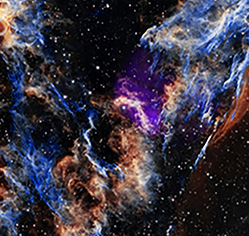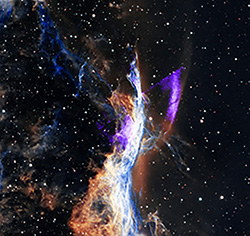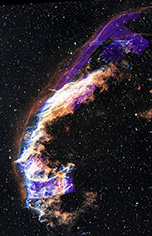
The Cygnus Loop in 3D
The Cygnus Loop, also known as the Veil Nebula, is a vast supernova remnant located approximately 2,600 light-years away from Earth in the constellation Cygnus. Spanning about 120 light-years across, this structure is the result of a massive star that exploded between 5,000 and 10,000 years ago. The explosion sent shock waves rippling through the surrounding interstellar medium, heating the gas to millions of degrees and creating the intricate, filamentary structures we observe today. The original supernova would have been bright enough to be seen clearly from Earth with the naked eye.

The Cygnus Loop (also known as the Veil Nebula) is a supernova remnant, the remains of the explosive death of a massive star. Credit: X-ray: NASA/SAO/CXC; Optical: John Stone (Astrobin); Image Processing: NASA/SAO/CXC/L. Frattare, N. Wolk
Scientific Significance
Cygnus Loop Zoom & Morph: Though a doomed star exploded some 20,000 years ago, its tattered remnants continue racing into space at breakneck speeds – and NASA's Hubble Space Telescope has caught the action. Credit: NASA, ESA, STScI; Acknowledgment: NSF’s NOIRLab, DSS, Akira Fujii, Jeff Hester, Davide De Martin, Travis Rector, Ravi Sankrit (STScI)
Studying the Cygnus Loop provides valuable insights into the life cycles of stars and the dynamics of supernova remnants. The interaction between the blast wave and the interstellar medium offers a natural laboratory for understanding shock physics and the processes that enrich the galaxy with heavy elements. Observations across multiple wavelengths, including infrared, optical, ultraviolet and X-ray, have been instrumental in unraveling the complex morphology and composition of this remnant.
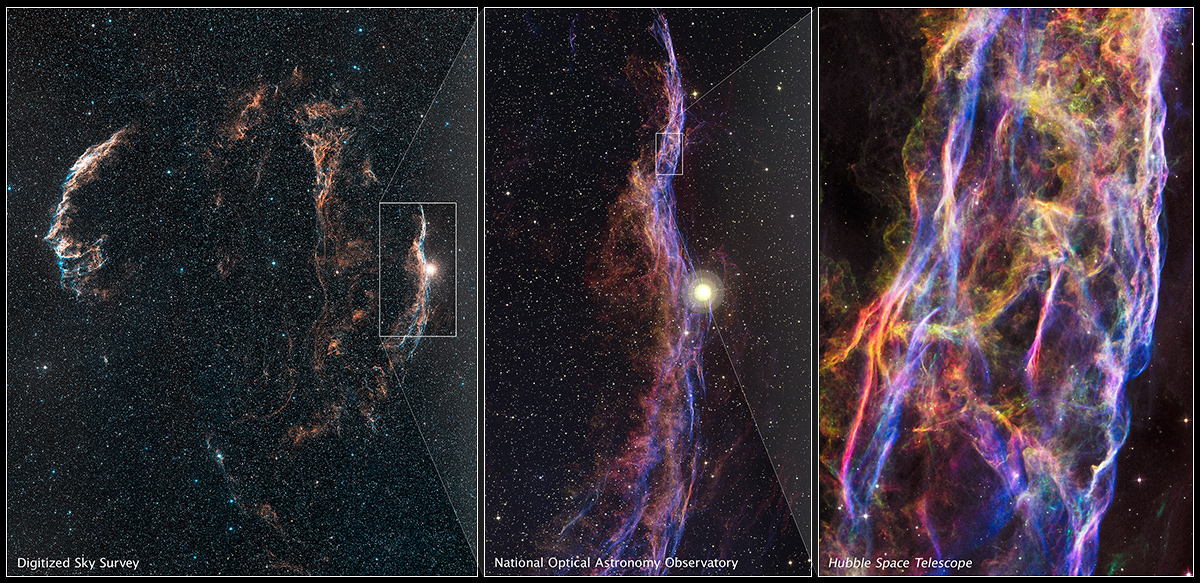
Cygnus Loop & Location of Veil Nebula. Credit: NASA, ESA, the Hubble Heritage Team (STScI/AURA), Digitized Sky Survey ((DSS) STScI/AURA, Palomar/Caltech, and UKSTU/AAO), and T.A. Rector (University of Alaska, Anchorage) and WIYN/NOAO/AURA/NSF
Several NASA telescopes have observed the Cygnus Loop across the electromagnetic spectrum. The Hubble Space Telescope captured striking optical images of pieces of the remnant’s delicate filaments, revealing fine-scale structure in the shock fronts. NASA’s GALEX shows filaments of gas and dust visible in ultraviolet light that were heated by the shockwave from the supernova, which is still spreading outward from the original explosion. Spitzer Space Telescope detected infrared emission from warm dust and gas, helping scientists trace how the shock wave is interacting with surrounding material.
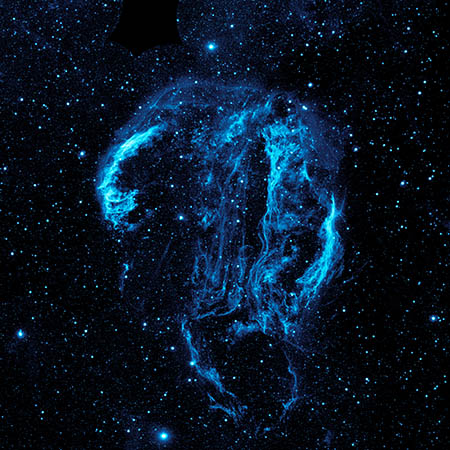
Wispy tendrils of hot dust and gas glow brightly in this ultraviolet image of the Cygnus Loop nebula, taken by NASA's Galaxy Evolution Explorer. The nebula lies about 1,500 light-years away, and is a supernova remnant, left over from a massive stellar explosion that occurred between 5,000 to 8,000 years ago. The Cygnus Loop extends over three times the size of the full moon in the night sky, and is tucked next to one of the "swan's wings" in the constellation of Cygnus.
The filaments of gas and dust visible here in ultraviolet light were heated by the shockwave from the supernova, which is still spreading outward from the original explosion. The original supernova would have been bright enough to be seen clearly from Earth with the naked eye. Credit: NASA/JPL-Caltech
NASA's Chandra X-ray Observatory has been pivotal in exploring the high-energy phenomena within the Cygnus Loop. Chandra's X-ray data reveal regions where the shock wave has heated the gas to temperatures exceeding a million degrees Celsius. These observations highlight the distribution of various elements and the physical conditions within the remnant, contributing to our understanding of the mechanisms driving supernova explosions and their aftermath.
Close-ups of the Cygnus Loop’s lower right, middle right and upper left areas with optical data (orange, light blue, white) and X-ray data (violet-purple). Credit: X-ray: NASA/SAO/CXC; Optical: John Stone (Astrobin); Image Processing: NASA/SAO/CXC/L. Frattare, N. Wolk (NASA's Chandra Releases New 3D Models of Cosmic Objects)
Additionally, the Far Ultraviolet Spectroscopic Explorer (FUSE) and earlier missions like ROSAT and Einstein Observatory have also provided valuable ultraviolet and X-ray data, respectively, rounding out our multiwavelength view of this complex and evolving structure.
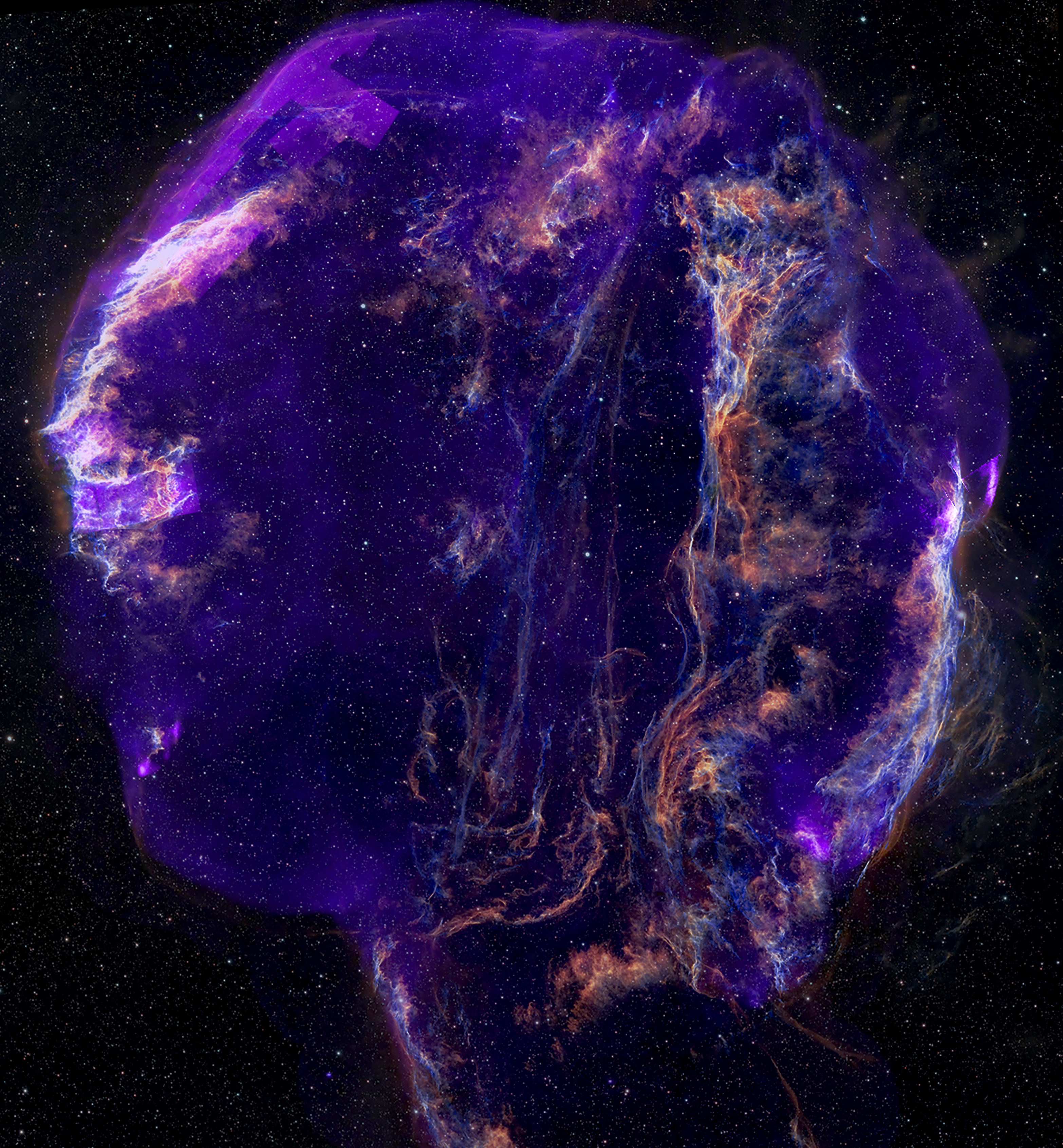
Full Cygnus image with optical (orange, light blue, white), Chandra X-ray (bright violet-purple), ROSAT X-ray (deep purple). Chandra X-ray: NASA/SAO/CXC & ROSAT X-ray: MPE; Optical: John Stone (Astrobin); Image Processing: NASA/SAO/CXC/L. Frattare, N. Wolk, K.Arcand
The Cygnus Loop in 3D
This is a simulation showing the interaction of a blast wave with an isolated cloud of the interstellar medium. The shocked cloud is at the center of the scene and is clipped so the viewer can see the internal structure. The color indicates the distribution of mass density highest (red) and lowest (blue). The streamlines indicate the direction of plasma flow. The cloud is heated up to temperatures of tens of million degrees by the blast wave. The shock may have been generated by a supernova explosion or by the fast wind from a nearby massive star. Credit: INAF-Osservatorio Astronomico di Palermo/Salvatore Orlando
This 3D model of the Cygnus Loop is based on a simulation that describes the interaction of the supernova blast wave with an isolated cloud of interstellar material (that is, dust and gas in between the stars. The shocked cloud is at the center of the scene and is clipped so the viewer can see the internal structure. The color indicates the distribution of mass density highest (red) and lowest (blue). The streamlines indicate the direction of plasma flow. The cloud is heated up to temperatures of tens of million degrees by the blast wave. The shock may have been generated by a supernova explosion or by the fast wind from a nearby massive star.
3D Printing Cygnus Loop: Download the 3D Model
By translating models and observations into a tactile format, such a model allows for an immersive exploration of the remnant's complex morphology.
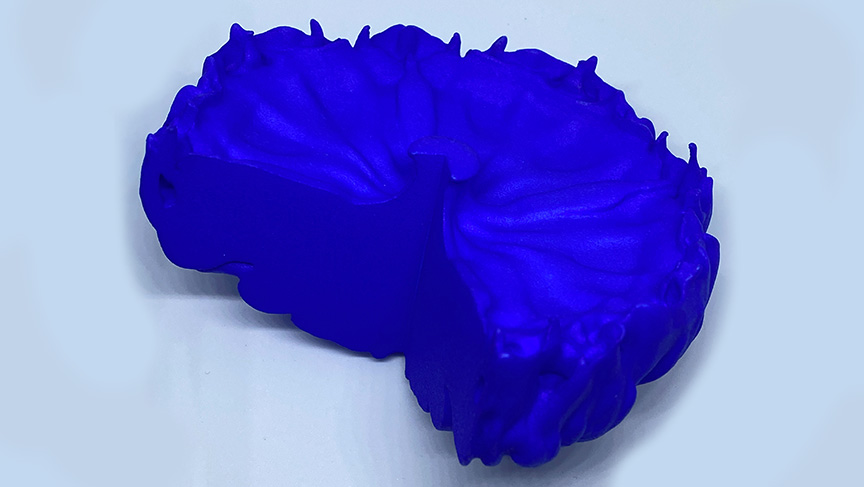
The Cygnus Loop model examines a cloud of interstellar material interacting with a superheated, supernova blast wave. The model resembles a bowl with a thick base, and a wedge cut from the side like a slice of pie. The sides of the bowl appear solid. 3D Print Credit: NASA/CXC/SAO/A. Jubett & N. Wolk, based on a model by Sal Orlando
These files are compatible with most 3D modeling software and printers.
Printing Recommendations
Printer Type: FDM or SLA printers
Material: PLA filament or resin
Layer Height: 0.1 mm for optimal detail
Supports: Recommended for any overhanging structures
Scale: Adjustable to suit tactile needs or display purposes
Learn More
The Cygnus Loop is part of a growing library of 3D printable astrophysical objects developed using NASA and other astronomy data and mathematical models. These models are designed to make cutting-edge science more accessible, helping lifelong learners mentally map and understand the fundamental processes that shape our universe.
Explore more exploded stars, neutron stars, and other objects in 3D
RESOURCES
DOWNLOADABLES
LINKS TO OTHER ACTIVITIES
Published: May 2025

